Joy Lewis's Blog
September 8, 2023
What happened in A Thorn among Fae? A Quick Recap before A Crown for the Cursed
The following contains spoilers for A Thorn among Fae. Read at your own risk.
Anova is a thief and con artist living in the bustling shipping city of Irbess. Irbess is the closest human-controlled land to the fae territories adjacent to it, and the city is heavily taxed by the fae. Anova and her childhood best friend Juras are deeply in debt to the madam of the brothel their mothers used to work at. After Anova’s mother’s murder by the fae some years ago, she is tasked with the debt incurred to the brothel from their lodgings and other living expenses.
In order to raise the money to pay off their debts and leave the city on a ship for greener pastures, she and Juras operate a con most nights at different taverns throughout the city. They pretend to be engaged, stage a fight in which Anova is dumped by her cheating fiancé, and fish for men who would prey on a drunken girl. Once Anova gets the men alone, she incapacitates them and robs them.
The night after a successful job, Madam Hinterfell corners them on the street, takes all they made the night before, and makes an ultimatum: pay in full before their eighteenth birthdays in a few months, or she’ll take the case to a judge who could order the two to legally pay off their debts to Hinterfell by working for her. This threat carries even more weight because Hinterfell could try to bring evidence of their crimes to light, as well.
But during their next con in a new tavern, something goes wrong. Anova’s target knows her real name and, once they’re alone, he reveals that he’s been watching her for some time. He’s revealed to be one of the fae, a young mysterious fae lord called Leander. He wants to hire her for an assassination across the border in the fae lands. He insists her skills at pretending to be someone else are vital to the job.
Anova accepts, though she doesn’t tell him she intends not to kill anyone, but to rob him blind and return to Irbess as soon as she can flee Fae. She promises Juras she’ll come back and pay their debts with the money before it’s too late.
On the way, Anova discovers that Leander intends for them to assassinate the corrupt fae High King, only the most powerful fae who lives. Unlike the moonlight magic the other fae use, the High King or Queen is granted unrivaled power through an ancient fae artifact known as the blood crown. The crown also gives the owner the right to rule over fae, and it’s passed on through murdering the previous owner.
Because of this and his fear of a militia rising against him, the High King has grown paranoid and rules Fae with oppressive restrictions. Weapons are outlawed except those carried by his guards, fae families are allowed only one child per pairing, and similarly, families are only allowed one servant at once.
Those found violating these decrees are either punished cruelly or executed.
Leander’s family, including his twin brother, was murdered by the High King. He and his fae manservant, Nerium, have formed a plot to assassinate the king and destroy the blood crown for good. According to the lore they’ve studied, fae artifacts generally don’t affect humans like they do the fae, so they theorize that a human killing the High King will end the line of corrupt fae rulers.
However, as Leander sneaks Anova inside Fae’s borders, they are stopped by three of the king’s guards. They point out that Leander already has one servant, and Leander’s plan almost fails before it begins. They are forced to pretend that they are lovers rather than a human servant and fae master. Hellmyr, Leander’s former friend who has joined sides with the king, allows them to pass after remarking that he always knew Leander had odd tastes.
Once in Fae, Leander trains Anova in the secret training grounds inside his manor. They practice using swords, fight in hand-to-hand combat, and study poisons growing from plants inside his greenhouse and their effects.
Over time, he reveals more about his family. His twin brother, Cadmus, had a reputation for war strategy and the arts of combat while Leander was the studious, bookish brother who loved plants and lore. Their father was the king’s right hand, but the king grew suspicious and ordered his family executed except for one survivor to live and spread word of his deeds.
There is also a romantic rival vying for Leander attention, the fae lady Lycasta.
On the eve of a party that they are to attend in order to gain access inside the king’s castle, Anova decides she must steal her bounty and leave that night or not at all. Inside Leander’s chest, she finds a valuable ring and a note signed from his mother to his brother, Cadmus. Their mother urges him to live on without them.
In a change of heart, Anova leaves the ring and escapes on an enchanted butterfly steed to find another fae manor to steal from. However, when she lands, she finds the next manor empty.
He has followed her, and Anova realizes all the houses in this territory of fae are empty. Leander explains that most families here were wiped out by the fae king.
In an emotional reveal, Leander admits to Anova that he isn’t who he’s said he is.
The twin boys often switched places when they grew up, and the king had intended for the other brother to be left alive. In other words, he was supposed to have died instead of his brother.
Leander has lived the rest of his life since his family’s murders as his dead twin brother. In reality, he is Cadmus, the tactician. Leander was supposed to have been left alive as the harmless son, and he feels he stole his brother’s right to live. The High King has never found out his mistake, or so Leander (Cadmus) hopes.
This also means Lycasta has been in love with the wrong fae for years, believing him to be his dead brother, though Leander can’t correct her. He has instead rejected her advances with no explanation.
At last, Anova agrees to help him assassinate the king. At the castle, the High King reveals he will invade the human lands in less than two weeks. The two are unable to kill him though their plot remains undetected by him.
Anova, Leander, and Nerium regroup. They discover a story in a book that explains the origins of the blood crown in the form of a fairy tale.
In the fairy tale, a human witch’s son fell in love with a fae princess. Her father forbade the match, but the two met every night in the woods by the light of her lantern. The-then king discovers this, and enchants his daughter to sleep during the night while he takes the lantern to the woods. He leads her human lover over a chasm where he falls to his death.
The boy’s mother, the witch, discovers what has happened, and puts a deadly curse on the ruling fae. Because of this, the princess wakes in time to find out, and in a fit of grief and wrath, murders her own father. Left with no other heirs, the fae people are forced to recognize her as their new ruler. This is what causes the curse on the crown and the bloody succession that follows.
When the High King arrives at their manor and finds evidence incriminating only Anova, Leander orders her back to the human lands in punishment, but, unbeknownst to her, also to save her life. He doesn’t realize he’s delivered her straight to Madam Hinterfell.
With Juras’s help, she escapes prison in Irbess and Hinterfell’s clutches. Even with a broken heart, Anova realizes she’s the only one who can stop the fae invasion and end the reign of corrupt fae. She crosses the border into Fae again, and Nerium explains that Leander was trying to save her life when he banished her rather than punish her for seemingly trying to poison him.
Nerium says they discovered that their plan wouldn’t work. The end of the fairy tale explains that the witch had to sacrifice her own life to complete the curse. Ultimately, the blood crown is incompatible with humans, and would kill them if one got control of it.
Nerium also says that Leander has chosen a terrible fate to accomplish his goals—he plans to kill the High King, and then eliminate himself in hopes of destroying the blood crown with the deed. The two leave for Wolfsbane manor where the king’s army is stationed in order to infiltrate his ranks and save Leander. Nerium suggests an alternate plan—that if two fae killed the king at once, it may destroy the crown intent on only one of them becoming its master.
They talk with Leander, who is pretending to be the king’s general in the war they march to. He agrees to their plan, and they enact it during a feast the night before the invasion should start.
However, it’s a trap. The High King reveals he knows that Leander is actually Cadmus. He poisons Anova with a hallucinogenic and orders Hellmyr to kill her. Instead, he fakes her death and locks her inside a closet to save her while the army leaves.
When she wakes, Anova rides to stop the fae army and its king. Even if it means her death, she decides this is her destiny. They’ve gathered at the border between their lands. With the help of one of the king’s consorts, Letharia, Anova disguises herself as the fae lady with the intent of poisoning him.
Not yet known to the king, Letharia reveals that Hellmyr is her and the king’s son. He is the only blood heir to the crown, and she plans on supplanting the king with her son once the crown is destroyed.
The fighting between the fae and humans has started. The High King has thrown the beaten Nerium and Leander into a cage with human children and lit it on fire to persuade the humans to give up. To save Leander and both their worlds, Anova applies wolfsbane poison to her lips and kisses the king when he thinks she’s Letharia, thereby poisoning him.
The poison also affects her, however, and she collapses. In the meantime, Leander gets himself and the other prisoners out of the cage. Hellmyr runs his father through with a sword, dealing the killing blow to the king. Leander discovers that Anova’s body has gone cold. He’s too late.
But instead of answering to Hellmyr, the blood crown chooses Anova. She lives.
When she wakes, Anova realizes what’s happened. She flees a house she’s being kept inside by an unknown party, fearing for her life now that she’s the biggest target in all of Fae.
The post What happened in A Thorn among Fae? A Quick Recap before A Crown for the Cursed appeared first on Joy Lewis.
December 27, 2022
A Thorn among Fae
Trigger warnings available here.
This is raw, unedited material. Some errors may be present. Expect minor changes upon publishing.
Table of ContentsChapter OneChapter One“I’d bet you won’t last twelve months of being married to me before there’s something growing in your belly.”
Their neighbors at the closest table leaned ever so slightly forward, their chins tilted at a level not quite perpendicular to the tavern floor anymore.
The wife-to-be in question, a young one by the pretty luster of her fair skin and the set of her ruby mouth, hid something like a smile behind a quick hand pressed to her mouth.
Red crawled up her cheeks. The whole tavern had heard, surely. “Delen,” she shushed the dashing young man sitting beside her as she squirmed in her seat.
They were young to be married, but there was little doubt in the minds of the tavern patrons that the girl’s family had needed the bride price. There were more than a few in the city who were exchanging daughters for some extra coin after the last increase in taxes from the fae bastards across the boundary line.
The young man’s eyes, gray as a morning in winter, glinted with something shared only between them.
“You’ve barely lasted all our engagement,” he said, apparently not cowed by her attempts at shushing him, “without a little me in you.”
“Delen,” she said louder. Her hand pressed deeper against her mouth, like she could take his words back by smothering her own. A wave of brown hair pressed against her features, hiding the rest of her face from the world.
Delen’s fingers slipped between hers where she had placed her other hand in her lap. “Ana. I love you with my entire heart and soul. I love you more than my life.”
The intimacy of the moment diverted the stares that had been thrown their way. A confession of love between fiancés wasn’t nearly as interesting as the snippet that had preceded it.
The Last Chance was perhaps a bit of a melodramatic name for a tavern, but it was usually anyone’s last chance to drown themselves in fermented starch in the entire city of Irbess. Bordered as it was by the fae-controlled territories west of it, it was any Irbess dweller’s last chance at seeing a friendly face, too.
As the shadows thrown by the hearth in the center of the tavern grew longer, their eavesdroppers grew bored with their drink and how regular the conversation upwind had grown. Soon, they abandoned their mugs and the rings left on the tables by them and headed to their own rooms for finer conversation.
It was only just midnight when the tenor of the engaged couples’ conversation changed. Empty mugs sticky from dried drink sat before them on the table.
“What are you saying?” Her hand, burdened by a modest band of silver indicating their engagement, caught the light of the fireplace’s faltering glow as it flew to her throat.
“Nothing,” Delen snapped. His fingers raked the strands of his combed curls as his eyes cast anywhere but at his beloved. “Just … leave it be, Ana. You’re talking too much again.”
“But—” Ana’s face was red. “You said you don’t want to marry yet. What others were you talking about? Other girls?”
Delen stood, and his chair nearly fell from the force. “I’ve had enough of your nagging already. Tell your da it’s over.”
“But Delen—” Ana’s words ended in a cry when Delen slammed the door of the tavern behind him.
Her hair piled around her where she pressed her face against the wood of the rickety table where they’d sat together. Her shoulders quivered. She was alone with their empty cups and the plates of their picked-clean supper. When her wrist flew from her side to smudge at her wet face, she knocked one of the cups to the floor where the last of its contents dripped, soaking into the floor and joining generations of stains. She smelled of ale.
There were markedly fewer patrons of The Last Chance left to have seen the argument, but there were enough.
After a short while, the man who had been watching her from the start rose and fitted himself where Delen had sat.
By now, the hearth was nearly cooled. The barperson didn’t look up from his work where he sopped sudsy water into the floor, trying in vain to erase another day’s worth of footprints and dirt.
There was no one left to hear the stranger’s murmurings to the girl.
* * *
The girl whose alias was Ana stiffened in her seat ever so slightly when the man’s hand grazed her lap. She wasn’t nearly as drunk as she had let on, so she could very clearly feel his fumbling, yet determined, attempts to get at what was under her dress.
She would relish this next part.
Just get through it.
The man’s eyes were hard and black like beetles. His skin had a sallow cast to it, as if he were always standing underneath the last minutes of torchlight in the streets of Irbess. In this city, the grime caked onto the lanterns’ glass gave the flames an uncomfortable glow at night.
She found that, equally so, the men who wanted to prey upon her were pretty and ugly. This one was not pretty.
It mattered not to her.
She allowed him to lead her upstairs, swaying on her feet when his arms weren’t all over her, which was most of the time. When they stopped before a door, he produced a key.
As soon as the lock clicked back into place, the man turned to her, his fingers groping at the ties holding together the back of her dress.
His chin pressed into her collarbone as he whispered, “You won’t remember any of this come morning, darling. Best to lie down and let me do what he won’t anymore.”
It was then that the bones in his fingers crushed like brittle, dead leaves. She knew with a hard certainty that a bone in his thumb broke as she forced it to bend at an angle that was almost hard to witness.
Almost.
As her hands were occupied behind her back, she kicked him in his manhood. Her hands were like a prison around him. The strings to her dress remained knotted together.
She never let a man touch her without touching him back just as hard.
She forced them both into his room, and he rolled like a barrel to her delight.
“You broke my hand,” he screamed. His good hand was wrapped around his injured one like that would fix it.
Oops. She was supposed to keep them from screaming when she got them inside.
She crouched above him. “You need to be quiet, or there’ll be worse than that,” she threatened.
“You—you little harlot! You did this on purpose,” he yelped much too loud.
The girl smirked. She liked that insult. It was like an old, worn coat. She could don it and cast it aside whenever she wanted.
“Clearly,” she said, her eyes already on the heavy ring hanging off one of his good fingers. “Give me that.” She nodded at it.
The emerald embedded in the metal stared back at her, glimmering in the low light of the room. How nice it would look sitting on her own finger—
Pain raced across her scalp. The foul man under her had clamped his good hand around her hair and was yanking it repeatedly to the ground.
She cursed herself. She’d been careless.
The girl ignored the pain as she slammed her foot into his throat. She should have silenced him before now. His legs thumped against the floor, and she prayed that those on the floor below thought that they were roughhousing for other reasons than to hurt each other.
When the man slumped into an uneasy unconsciousness, she emptied his pockets, saving the ring for last as she slipped it onto her own finger.
Her fingers lingered on his coat. It was sewn doubly thick compared to ones she’d seen before, lined as it was with fleece. It was perhaps the warmest coat she could remember feeling against her skin.
Winter is coming again.
The girl looked down at the fat emerald. Usually, they tried to limit the items they stole that could be traced back to them. Coins were best, but she allowed herself a piece of jewelry or other trinket every now and again. It put a bigger target on them, she knew, but it also raked in the coins.
Clothes would never fetch as much as a ring would, double lined or not.
She remembered the night before, and the chill seeping into their bones as they’d huddled together in their home.
The girl sighed and replaced the ring on the man’s finger before slipping the coat from him. At least the coins amounted to a comforting weight in her pockets.
The girl whose alias had been Ana for the night left the room and the man behind. Buried in the coat’s pockets, her fingers flipped one of the coins over and over as she thought of the meals that she and her partner would eat for the next several nights.
Purchase A Thorn among Fae on AmazonThe post A Thorn among Fae appeared first on Joy Lewis.
May 11, 2022
We Need More Antagonists Like Gollum
Whether you know him as Gollum or Sméagol, he’s one of the most compelling antagonists of both The Hobbit and The Lord of the Rings by J. R. R. Tolkien.
Before the events of The Hobbit, Sméagol fell under the corrupting influence of the One Ring when he choked his cousin to death to possess it for himself.
But, like all great antagonists, his character isn’t as straightforwardly evil as you might first believe. In fact, he’s not even a villain.
The difference between antagonists and villainsFirst, some semantics. Although often used interchangeably, antagonists and villains serve different functions in a narrative.
Zara Altair at ProWritingAid argues that the antagonist is one of the troublemakers in a story. They challenge the main characters, blocking their path as obstacles and creating friction when they want the same–or opposite–thing as the protagonists. A villain is marked by a desire to destroy, inflict pain, or otherwise be bad.
In other words, antagonists are defined by their relationship to the protagonist. They oppose your main character. That’s all. Antagonists can be good, bad, or somewhere in between.
They can even be allies with the protagonists, though rivals or sworn enemies certainly make an antagonist, as well. All that matters is that they get in the way of what our main character wants.
Think, for example, of Ron’s character in Harry Potter and the Goblet of Fire. Ron’s not evil, and while their relationship suffers, he’s never not Harry’s friend throughout the book. On the other hand, it’s Ron’s actions and his distance from him in his time of need that put even more obstacles in Harry’s path before he faces the first tournament task.
On the other hand, villains aren’t always antagonists, though they usually are. This is possible because in infrequent cases, they are the protagonists.
While Sauron is indisputably the villain of The Lord of the Rings series, and a fearsome antagonist for Frodo, he is by far not the only antagonist.
And not even the most interesting one, in fact.
In his quest to destroy the One Ring and prevent Sauron from dominating Middle Earth, Frodo is challenged by no short list of antagonists. The Ringwraiths, orcs, Saruman, Sauron, Shelob, and both Boromir and Faramir (briefly) oppose Frodo.
But there’s something about Gollum that fans keep returning to. And it’s because, at least in part, we’re uncomfortable with Gollum.
He’s a Cain-like figure.Sméagol’s tale begins on his birthday. His cousin, Déagol, finds a precious ring in the river that they had been fishing in, and when Sméagol demands it as a birthday present, he refuses to give up the ring. The madness of the ring drives him to kill his kin for it.
But it’s what happens after that sets Sméagol on this path. The matriarch of his family, his grandmother, refuses to have him in the family’s home any longer. When the rest of his kind shun him as well, Sméagol retreats to the Misty Mountains as his home.
In the centuries he lived in the darkness, consuming bats, fish, and sometimes Goblin flesh, his will was bent completely by the One Ring. It was then he developed his dissociative identity disorder, and Gollum came to be.
What bothers us about Sméagol/Gollum?Even aside from his origins, Gollum is a tragic character. Despite some brief cooperation due to Frodo possessing the ring and thus holding power over him, he’s not allied with the good guys.
But he’s certainly not with the bad ones, either. Although, just like how he guides Frodo and Sam to Mordor against his better judgment, he becomes an unwilling pawn for Sauron.
Orcs, men, and hobbits alike despise him upon sight as a “sneak” and low creature.
He has no real allies.
Sometime after Bilbo left the Misty Mountains with the ring, Gollum leaves his caves in search of it. He is compelled to Mordor where he is captured and mercilessly tortured by Sauron for information on the ring.
After Sauron extracts all that he can from Gollum, he releases him in hopes that Gollum will attract the ring from where it’s hidden from his view. And it works.
And it’s Frodo, one of the few people to show him kindness, who draws out the innocent-seeming Sméagol part of his personality. Sméagol more closely resembles the hobbit he must have been before the ring’s corruption. This reminds us that he’s not entirely the monstrous creature he’s initially portrayed as.
It’s these scenes that make him a pitiable antagonist.
Infantilization makes us uncomfortable with hating him.In the arguments between Sméagol and Gollum, Sméagol is revealed as the “good” part of his personality, who seems to possess morals and something like compassion and kinship.
He strives to obey and please his “master” and hardly dares speak against him even in confidence. The character of happy, naive Sméagol is infantilized in the narrative.
This makes it uncomfortable to hate him, even after he plots with Gollum to take back the precious.
It’s much easier, psychologically, to despise absolute evil such as Sauron. As Ursula K. Le Guin put it, “Immature people crave and demand moral certainty: This is bad, this is good.”
However, Sméagol isn’t neatly bad or good.
Sméagol’s childlike characterization is juxtaposed with what feels like one of the worst crimes portrayed in The Lord of the Rings. Sméagol’s sin of fratricide.
Gollum occupies a space that’s uneasy for the audience to watch. It’s why we need more antagonists like him.Tolkien expertly flips our expectations. Gollum isn’t a villain, though he has committed a crime that feels more personally gruesome than the uncountable, faceless sins of the undisputed villain of The Lord of the Rings.
However, it’s the moral uncertainty and complexity of Gollum that make him a far more compelling antagonist.
What do you think about Gollum’s role as antagonist?The post We Need More Antagonists Like Gollum appeared first on Joy Lewis.
April 13, 2022
5 Bookish Characters in Young Adult Fiction You Should Know about
This post contains Amazon Affiliate links. This means that at no extra cost to you, I may be compensated a small percentage if you click these links. This keeps my website up and running, so thank you for your support!
Being a bookworm never looked this cool for us, but that’s okay!
I think there’s a sort of wish fulfillment going on when we see bookworms as the stars in fiction. As someone who grew up with her nose in a book at all times, I remember feeling validated whenever I saw the bookish, nerdy heroine prevail because of her book smarts. This is contrast to stories that show her ripped from her books and made over as “popular” or otherwise more like the status quo.
Instead of being sidelined as the stock “smart” character, these books take the book-obsessed and celebrate them as they are. And if we’re reading about them in books, why wouldn’t we cheer for our fellow bibliophiles?
5. Elisabeth Scrivener – Sorcery of Thorns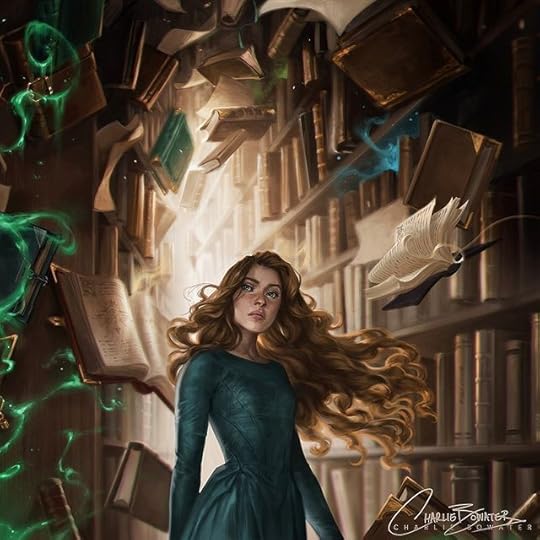 Image by Charlie Bowater
Image by Charlie BowaterThe world of Sorcery of Thorns itself is an ode to bookworms. Elisabeth was left as an infant on the steps of the Great Library of Summershall, a library that houses dangerous and magical grimoires. She becomes a librarian’s apprentice and a fierce lover of books as she grows.
The thing is, the books in this story are alive.
When The Book of Eyes is turned into a monster by an unknown culprit and a murder is committed, Elisabeth is the only suspect. Can she prove her innocence?
“You like this place?”
“Of course I do, it has books in it.”
Margaret Rogerson, Sorcery of Thorns
Check out Sorcery of Thorns on Amazon.
4. David Kostyk – Grishaverse Series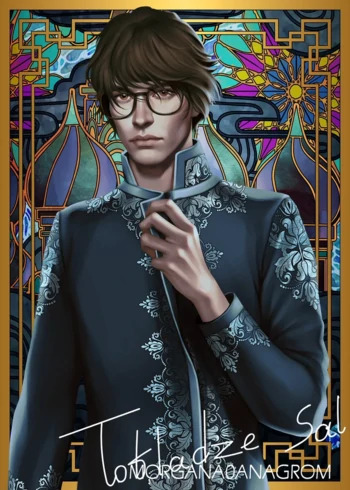 Image by morgana0anagrom
Image by morgana0anagromDavid is a Grisha who first appears in Leigh Bardugo’s Shadow and Bone trilogy. As a Fabrikator, he works with metals, glass, and anything solid, manipulating their forms on a molecular level with his Grisha power. He’s singularly obsessed with his work and research.
This brings me to Morozova’s journals. Ilya Morozova was one of the greatest Fabrikators, a martyr, and a Grisha pioneer who pushed the boundaries of what was possible with this power. He left behind his research notes within a stack of journals that has survived the ages.
The secret to defeating the Darkling–that is, the rumored third amplifier for Grisha power–remains undeciphered in Morozova’s journals. Even when others give up on the journals, David hauls them with him in Ruin and Rising in order to find the legendary firebird.
Readers have also hypothesized that David falls on the autism spectrum, an interpretation that I agree with. For those looking for autism rep in books, I believe his character is a casual nod to that.
“I… I don’t understand half of what goes on around me. I don’t get jokes or sunsets or poetry, but I know metal. Beauty was your armor. Fragile stuff, all show. But what’s inside you? That’s steel. It’s brave and unbreakable. And it doesn’t need fixing.”
Leigh Bardugo, Ruin and Rising
Check out The Shadow and Bone Trilogy on Amazon.
3. Vhalla Yarl Solaris – Air Awakens Series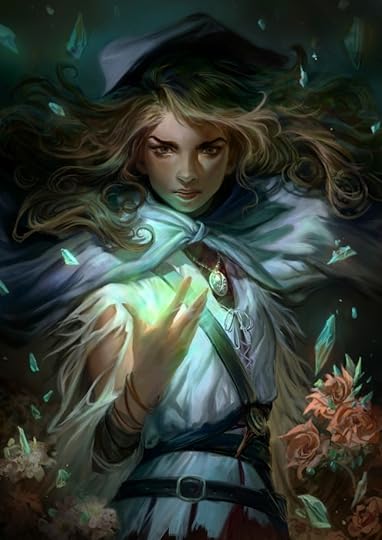 Image by Merilliza Chan
Image by Merilliza ChanAlthough she was raised on a farm, Vhalla’s mother taught her to read. It’s this ability and her father’s efforts that allow her to get a job as a library apprentice at the Imperial Library.
When one of the prince’s lives are at stake, Vhalla commits herself to finding the cure that will save him in the stacks of the library. Only, this isn’t the prince she wanted to save.
But it’s this dark prince who sees something in Vhalla that no one else has, and it’s something their world hasn’t seen in ages.
“I was raised in a world where I had thousands of friends, each one waiting for me on a shelf every day.”
Elise Kova, Earth’s End
Check out Air Awakens on Amazon.
2. Bilbo Baggins – The Hobbit, The Lord of the Rings Series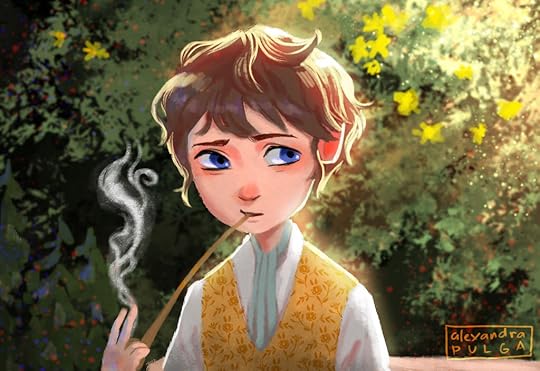 Image by Kairashima
Image by KairashimaBilbo has earned his place as a literary bookworm in more ways than one.
First, it’s impressive that he’s literate at all–let alone a bookish hobbit at that. Tolkien suggests in The Two Towers that many, if not most, hobbits never learn to read. In hobbit culture, this skill is placed in order of importance somewhere after cooking.
What’s more, Bilbo writes his own book, authoring his adventure to the Misty Mountain in There and Back Again. Although he certainly has his own adventure in The Hobbit, Bilbo can be read as a homebody. He’d rather work on his book than answer the door and invite his relatives inside.
All I have to say is, same.
“Books ought to have good endings.”
“I might find somewhere where I can finish my book. I have thought of a nice ending for it: and he lived happily ever after to the end of his days.”
J.R.R. Tolkien, The Lord of the Rings
Check out The Hobbit on Amazon.
1. Hermione Granger – Harry Potter Series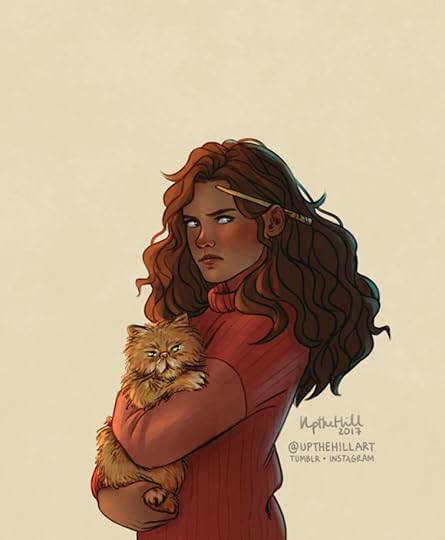 Image by UptheHill
Image by UptheHillI couldn’t leave out our most bookish icon of them all–the real reason Harry and Ron survived for six years of Hogwarts plus one on the run–Hermione Granger.
Time and again, Hermione pulls the guys out of a situation with knowledge that she’s gained from pouring over library books. There are almost too many moments to pick from to illustrate my point, so I’ll pick my favorite bookish Hermione moment.
In the second book, Hermione is petrified, along with several other victims. The heir of Slytherin and the heir’s monster won’t stop until a student is dead or until Hogwarts is closed. After failing to get any real answers from Aragog, Harry and Ron are at a dead end.
But Hermione’s already solved it for them.
In her petrified hand is a page ripped from a library book–a page on the legendary basilisk creature.
Even decomissioned, Hermione saves the day with her love of books and the habit of going to the library for answers.
An anthology full of bookworms, book thieves, enchanted libraries, and powerful grimoires is available for preorder now! Ink & Incantation celebrates the magic of books with 16 stories in a limited-time collection.“I checked this out weeks ago for a bit of light reading.”
“This is light?”
Harry Potter and the Sorcerer’s Stone (2001 film)
 Ink and Incantation
Ink and Incantation
Celebrate the magic of books with this limited-time collection of YA Sci-Fi and Fantasy stories.
What’s inside these enchanting pages?
A fae war is brewing, and only an ancient book has the power to stop it. If only the pages weren’t blank!A bookstore set in a steampunk world. The lights are flickering and objects are moving. Could the bookstore really be haunted?A doomed love story set in the last known library. Can two teens preserve what really matters?Two brothers. A wandering library. How far will they be willing to go to access this forbidden knowledge?And many more stories!Check out Ink & Incantation on Amazon to get lost in a world of books and magic!
The post 5 Bookish Characters in Young Adult Fiction You Should Know about appeared first on Joy Lewis.
March 30, 2022
Geralt’s Hotness Explained
If you’re familiar with The Witcher universe, originating from Andrzej Sapkowski’s book series of the same name, you’re familiar with the titular man in question.
Geralt of Rivia is a witcher, or a monster hunter for hire whose abilities have been enhanced with rigorous training and magic. Witchers are made through a dangerous ritual of blood and alchemy.
Although they are appreciated for their skills in slaying monsters that run rampant across the continent, they are often shunned by society as inhuman or other. They are even said to lack emotions, and this myth persists even among the witchers themselves.
The Witcher Saga has spawned a game series, a Netflix series, and even an animated movie. But one of these adaptations in particular has sparked an undeniable thirst for the character across the fandom.
There have been no lack of comments and jokes about which exact valley one should toss a coin into.
But why and how has Henry Cavill’s Geralt of Rivia become so hot to us? And why didn’t we drool over him when he was playing Superman in Man of Steel?
The answer is that the character of Geralt taps into a fantasy about men that women and men alike crave.An emotionally unavailable man is brought to his knees.
Although fans get a glimpse of what’s underneath Geralt’s exterior–the real emotions, painful scars, and vulnerabilities that all of us humans have–the myths surrounding witchers precede him.
They don’t feel like regular people do. They don’t have families.
And even when they save the day and kill the unimaginable monsters lurking in the forest outside the village, they were supposedly only motivated by money rather than a sense of righteousness.
But, over and over again, the audience gets an indulgence. We see Geralt’s soft spot.
In the first episode of the Netflix series, he is forced to kill the outcast princess Renfri when she starts to threaten innocents. He carries the guilt from this act like a physical weight when he takes Renfri’s brooch.
But perhaps one of the most powerful iterations of this fantasy of the aloof, emotionally distant man brought to his knees is when he is forced to adopt a teenage girl.
The Witcher wouldn’t be nearly so delicious if Geralt was a knight who always made the right choices and had rescued fifteen princesses before Ciri.He wouldn’t be so hot to us if he was a man who regularly saved realms and went around with clean clothing with a smile on his face everywhere (that is, Superman).
We don’t want to see that in the same way that we crave seeing a character like Geralt on the screen.
But what does that desire say about us?
It’s not quite as messed up as it seems.
Geralt is hot to us on two accounts. He gratifies the traditional image of a strong, silent warrior but–this is important–we see the propped up mirror.
We realize the illusions and smokescreen.
Underneath these, we see his vulnerabilities. The festering wounds. And there’s a sense here that we know his secret.
This grants an unspoken desire for us. It’s something that can be hard to put a name on as it’s all wrapped up in attraction and expectations of masculinity.He can pretend to others that he doesn’t have human emotions. He can joke when Yennefer suggests he should have had horns.
But this image is shattered when he is forced to become a parent figure to a young girl. A girl whose grandmother he watched fall to her death during the brutal siege of their kingdom.
From this moment forward, his life has changed. He can no longer pretend away his humanity and emotions like the world has expected of him.
But we weren’t fooled. We knew all along you had feelings, Mr. Rivia.
What are your thoughts on The Witcher? Did I hit the mark or miss it entirely?The post Geralt’s Hotness Explained appeared first on Joy Lewis.
March 16, 2022
3 Feminist Book Heroines for Women’s History Month
Happy Women’s History Month! While there are so many great literary heroines out there, I had to hold myself back. I could talk about this all the time, but I’m sure you had other plans for the day!
Without further delay, here are 3 heroines with some of the best character arcs that I can find. 3 who chose their own fates, defended those they love, and didn’t put down other women and girls to succeed. Enjoy!
This article includes Amazon affiliate links, and I may be compensated for clicks at no cost to you.
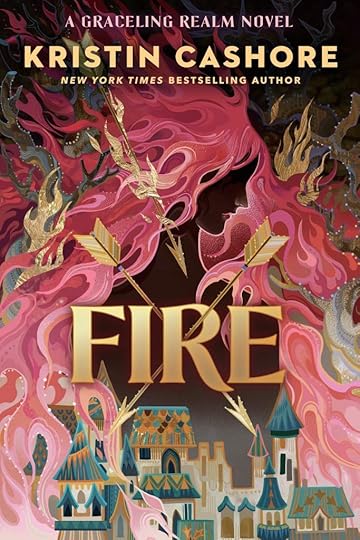 Fire, Kristin Cashore1. Fire from Fire
Fire, Kristin Cashore1. Fire from FireWhile Fire is the second book of Kristin Cashore’s Graceling Realm series, this story is much more of a prequel and can be read independently of Graceling.
Lady Fire is the last remaining human monster in the Dells where there are monster variations of everything from tigers to bugs. Monsters have brilliantly colored hair and pelts and mind control abilities which make them the perfect predator to humans and other non-monster animals. As a monster human, Fire is to humans what light is to moths. Most who merely look at Fire become obsessed with her against their will.
But all Fire wants is to be left alone.
Her father’s legacy is a shadow that she lives in every day of her life, despite Cansrel being dead for years now. When he was alive, he made the king of the Dells his puppet and committed atrocities that many would still blame Fire for.
You might think that an inhumanly attractive protagonist with the ability to read minds would be unrelatable. But Cashore uses the idea of the female seductress that’s pinned on women and girls and takes it to hyperbole in Fire. All Fire wants first is solitude and then to be seen as a person, not as a symbol of irresistible beauty. She hides herself from the world because she’s afraid of herself and the infringements she’s capable of committing by reading minds. When assassination attempts on the crown begin and war brews in the Dells, Fire is called upon to identify the enemy before it’s too late.
Over the course of the book, Fire grows into a heroine who uses her immense power for good rather than fearing her own capabilities. Something that I loved to see was that Fire stopped putting herself away into tinier and tinier boxes. By the end of the story, she has carved out a very visible place for herself in the world where she has support and a chosen family type of network. Additionally, she leaves behind a possessive, controlling relationship for a healthier one.
Just like in Graceling, Cashore paints a fantasy world that bucks traditions which have become ingrained in our world and so often sneak into fictional worlds by default. Characters freely have open relationships, periods and other realities of the body are real, and marriage isn’t the ultimate goal post for all female characters.
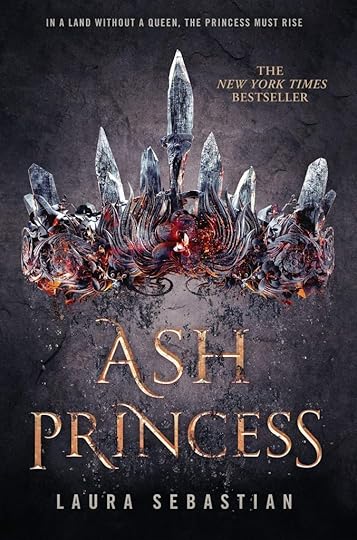 Ash Princess, Laura Sebastian2. Theo from Ash Princess
Ash Princess, Laura Sebastian2. Theo from Ash PrincessI knew I had to review Ash Princess the second I put it down, so perhaps the best introduction to this book is that:
“I couldn’t get enough of this book. It blasted my expectations to smithereens! If you love impossible choices, chosen family, stories of justice and rising up, heroines who get angry, and perfect, riveting tension, read Ash Princess.
Theo is a prisoner in her own conquered kingdom. The ones who invaded her land and murdered her mother, the queen? They’re the people she lives around. Her love interest. Her closest friend.
But she’s done. She would rather risk her life spying on them than waste another second pretending they don’t have the blood of her people on their hands.
There was so much in here that was done well that it’s impossible to say what I liked best, so I’ll just pick one. It was delicious to see justice come to those deserving of it, and I’m excited to see how the rest of this story plays out in the next book.”
My review on Goodreads
Theodosia’s arc to feminist heroine starts on a low point. She’s been prisoner to her land’s invaders for so long that the pieces of the girl she really is are buried under the facade that the Kaiser has forced her to wear for her survival. She has even accepted the new name they’ve given her, and her fear of the violent Kaiser runs so deep that she doesn’t even dare call herself Theo in her own thoughts.
When the last glimmer of hope is almost extinguished for her enslaved people, she decides to risk it all in a last attempt to defy her conqueror, the Kaiser, and become a spy and assassin.
But the road ahead isn’t so easy or clear. Theo must decide between her people and the lives of those around her–people she’s befriended and even loved despite their complicit involvement in her people’s oppression.
Ash Princess poses a delicious wealth of moral conundrums and questions that blend the lines of what it means to oppress/be oppressed. Above it all, Theo becomes a heroine who accepts herself and her background. Despite the events of the story, she grows into a kind hearted leader who is also allowed to be a complicated, fully dimensional character.
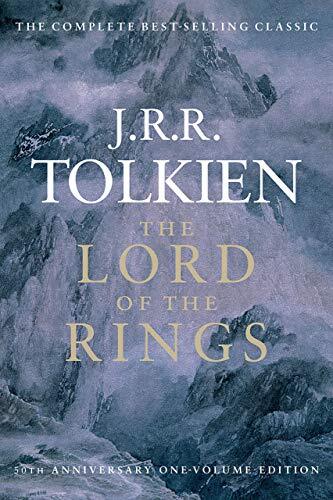 The Lord of the Rings: One Volume, J.R.R. Tolkien3. Éowyn from Lord of the Rings
The Lord of the Rings: One Volume, J.R.R. Tolkien3. Éowyn from Lord of the RingsI feel this article isn’t long enough to properly tackle this topic, but here goes nothing.
In one of the most memorable scenes in what is arguably the most famous of fantasy franchises, we have this iconic feminist moment:
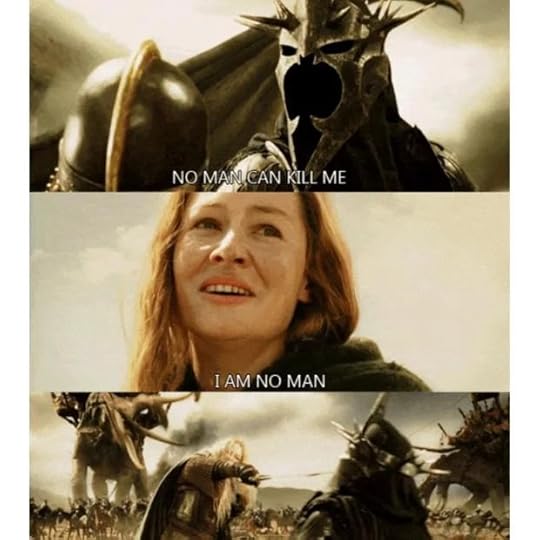 Éowyn reveals her identity to the Witch King before fatally stabbing him.
Éowyn reveals her identity to the Witch King before fatally stabbing him.But first, we need a little background. Éowyn is the adopted daughter of Théoden, Lord of Rohan, and for her first appearance in the story, she’s clearly being harassed by Gríma Wormtongue. We’re initially led to believe there’s little more to her character than her role as a victim and source of conflict/love interest for Aragorn.
Happily, we’re wrong.
Despite being expected to play the royal lady for the rest of her life who doesn’t dirty her hands, Éowyn wants battle. More than that though, she wants to defend her people and those she loves.
When her brother and Théoden leave with Aragorn and the rest of the assembled warriors to defend Middle Earth from evil, she knows she can’t stand by and allow them to die while she hides and does nothing.
She pulls a Mulan move and dresses as a man to join the other warriors from Rohan. She fights in the Battle of Pelennor Fields alongside her friend and hobbit, Merry.
Something I didn’t properly realize prior to writing this article is that Merry was only able to join the battle because Éowyn shared her horse with him. In The Return of the King, Théoden asks Merry to stay behind because none of the other riders could afford to carry such an extra burden. A mysterious man offers to share his horse and–you guessed it–that’s Éowyn. Even when this could jeopardize her secret identity and chance to fight, she extends a hand behind her.
You see, Rohan’s horses wouldn’t be able to support much weight outside that of an adult man’s and keep such a swift pace, but because they were both lighter than that, they could fight alongside each other on the same one.
While all this is cool, this isn’t enough to land her number one on this list.
While you might know of the prophecy of the Witch King that said he couldn’t be killed by men, you might not have known about the curse that afflicted any who tried to harm him. Those who did were said to be marked for death, and a quick but brutal sickness awaited any who tried.
I’ll set the scene. The Battle of Pelennor Fields has begun.
Still disguised as a man, Éowyn sees that the Witch King is about to kill her uncle and adopted father, Théoden. She knows she has to save him despite the horror of facing the living legend that is the Witch King. What is easily forgotten is the fact that she and Merry work together. He stabs him first which allows Éowyn to make that iconic stab to the face.
Despite the threat of the curse of the Witch King, they stand up for those they love and fight even after they’re told they would only be a burden and that their places are elsewhere.
Of course, there’s also the Witch King’s assumption of invincibility that came from only seeing men as a threat to him. While one can debate the semantics of what the Witch King meant, this scene is a satisfying subversion of the “I was expecting a man” situation so deeply rooted in sexism.
Éowyn’s place as a feminist heroine is only cemented further by the fact that she isn’t paired with Aragorn at the end of the story. While I love him, he’s decades older than her. Instead, Éowyn and Faramir seem to have a more equal partnership. I’m much more here for that.
See The Lord of The Rings on Amazon
I hope to have done these characters justice, but if you have other thoughts on this analysis, I’d love to hear them. What do you think? Have I missed someone who needs to be on this list? Let me know!The post 3 Feminist Book Heroines for Women’s History Month appeared first on Joy Lewis.
March 2, 2022
My Favorite Fantasy Short Story
This post contains Amazon affiliate links. I may be compensated if you click. Thanks for supporting my work!
Hey everyone! Today I wanted to talk to you about “Dragon Lake.” So this is a swan lake retelling, and if you’re not familiar with it, the original story goes: it’s one of those Dinsey-esque stories where it has a princess transformed into a swan that can only be transformed back by the kiss of a prince.
But “Dragon Lake” is pretty different.
So we start with Odette, and she’s got a pretty big problem. Every night, she transforms into a bloodthirsty dragon that doesn’t recognize friend from foe. And the only way to break this curse is by killing.
And Odette’s one kill away from ending it all. The only problem is that her last target is a handsome prince, a pretty good person. Who has actually treated her with some real humanity despite her condition.
What I love about “Dragon Lake” is that it’s a flip on the old situation where you have the princess being guarded the dragon waiting for the prince to save her. It takes that whole situation and turns it on its head. So it’s a nice little break from those traditional plot lines.
My other favorite part about this is that it’s a pretty quick story. Emotions start running high pretty fast. “Dragon Lake” is an emotional, tightly paced, action-packed gut punch of a story that I hope you’ll give a shot. Especially if you like a twist on those old, tired plots.
Thanks for watching!
If you liked my review, let me know or consider checking out Dragon Lake on Amazon!
The post My Favorite Fantasy Short Story appeared first on Joy Lewis.
February 15, 2022
5 Best Fae Couples in Romantic Fantasy
Fae characters and romance go together like peanut butter and jelly. Or more like peanut butter and Nutella chocolate spread because the combination is so decadent.
If you’re a Legolas over Aragorn kind of person, this is the list for you.
Because this list features couple combinations that are endgame, there will naturally be some spoilers for books. I’ve tried to note which entries contain spoilers, but read at your own risk.
This post contains Amazon Affiliate links. This means that at no extra cost to you, I may be compensated a small percentage if you click these links. This keeps my website up and running, so thank you for your support!
5. Valerian & Summer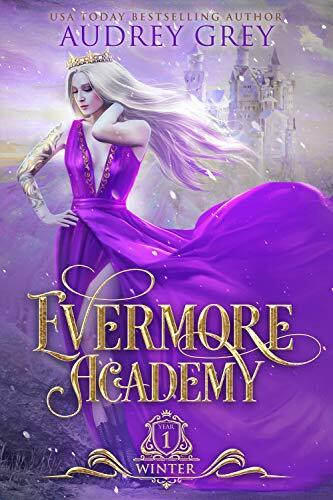
Book that they’re from: The Evermore Academy series by Audrey Grey
Contains a spoiler for book 1.
If you like your romances star-crossed, this is the one for you. She’s got the reincarnated soul of his fae lover who was the Seelie princess of summer. He’s the prince of the winter court, head of the Unseelie fae.
The only problem is, she’s not fae anymore. Actually, she’s from the middle of nowhere in the human lands, struggling to get by with her aunts and their adopted children.
When Summer steals from the fae to feed her hungry brothers and sisters, she’s sentenced to become a human “shadow” for one of the most vicious fae at the infamous Evermore Academy. Oh, and she hates the fae on principle.
For pretty good reason, it turns out! This world is not friendly to her kind. But when something sparks between them, courts will war and the human and fae worlds collide.
Tropes: enemies-to-lovers, academy, forbidden love, royalty
4. Rook & Isobel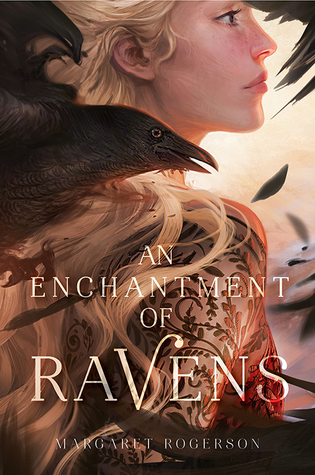
An Enchantment of Ravens by Margaret Rogerson
Book that they’re from: An Enchantment of Ravens by Margaret Rogerson
If you’re looking for a refreshing take on the fae with heartbreakingly beautiful prose, this is it. Isobel is an artist, but in a world where the fae visit humans for pieces of craft that they can’t hope to replicate, this is a dangerous profession.
Because for the fae, emotion is death. Anything made with it is beyond their skill, and they wonder even at the simplest displays of art. They trade with humans in tricks and bargains.
When the autumn prince commissions Isobel for a portrait, she doesn’t intend to violate the law of the fair folk, implicating Rook alongside her. But her world comes crashing down when she’s brought to his kingdom to answer for their shared crime.
Soon, Rook and Isobel aren’t just fighting for their lives anymore. They’re fighting for an impossibility, a future that can never be. Is their bond strong enough to survive?
Tropes: down the rabbit hole, forbidden love, savant, royalty
3. Feyre & Rhysand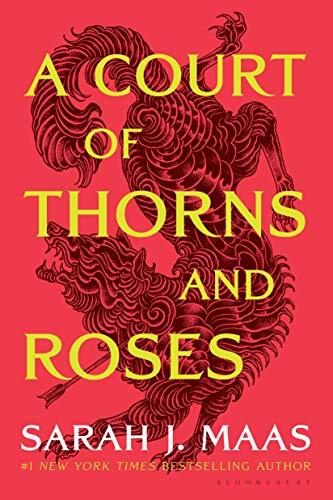
A Court of Thorns and Roses by Sarah J Maas
Book that they’re from: A Court of Thorns and Roses series by Sarah J Maas
Contains spoilers for book 1.
In an article about fae romances, I couldn’t NOT mention these two. They’re only the most (arguably) well known fae couple.
One of my favorite things about these books is that both Feyre and Rhysand have some serious trauma. While their love doesn’t automatically cure that, the books are great about showing how a partner can support the other while going through depression, for example.
More about the plot. She’s in love with another fae. He’s her unlikely ally in a nightmare. I won’t say more for spoilers, but this is one epic romance.
Tropes: enemies-to-lovers, power couple, steamy
2. Elkhana & Vidar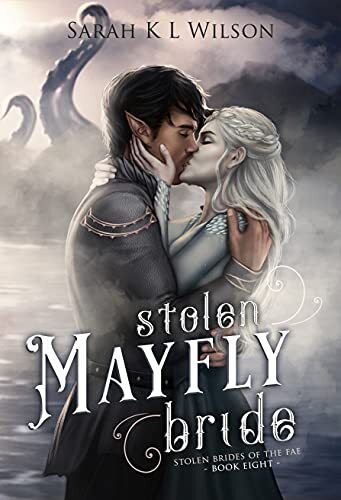
Stolen Mayfly Bride by Sarah K L Wilson
Book that they’re from: Stolen Mayfly Bride by Sarah K L Wilson
This book is the shortest on the list, but it has to be one of the most emotional. If you read none of the books on this list, give yourself a day to read this one. The writing is lush, and the story is even better.
Elkhana was sacrificed by her own people to take her place as their prophet, doomed only to live only one day a year.
The disgraced fae Vidar sees her for more than the humans do: a real person. Despite the fact that she can’t speak, the two start to form a bond. Even as decades pass, Vidar can’t forget her.
Can the curse of mayflies ever be broken?
Tropes: break out the tissue box, forbidden love
1. Jude & Cardan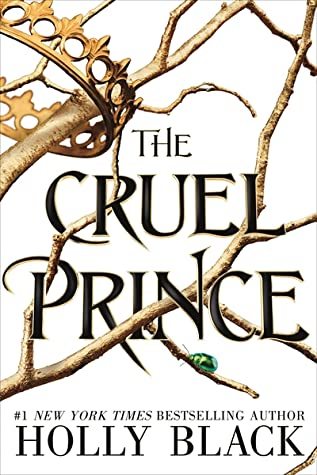
The Cruel Prince by Holly Black
Book that they’re from: The Folk of the Air series by Holly Black
Contains spoilers for book 1.
This entire list would be a massive lie if I didn’t include my favorite fae book of all time. Jude’s character arc is a case study in badass heroines. And Cardan is the perfect complement.
As the youngest prince of the mighty fae king, no one in his family expects Cardan to amount to anything. Along with her sisters, Jude is one of the stolen human children brought to faerie, and she’s spent her life proving her worth against the fair folk. This includes one of her biggest bullies: Cardan.
She’s tired of the humiliation and the constant reminder of her weaknesses as a human. But when a deal with a fae gives her the power she’s dreamt of, it’s more than she bargained for.
Together, these two make for a true enemies-to-lovers story. The hate is so real at first that you’ll wonder how Jude didn’t end up with Locke.
Tropes: enemies-to-lovers, badass heroine, royalty
Do you have any other fae couples to add to this list? Let me know with a comment!The post 5 Best Fae Couples in Romantic Fantasy appeared first on Joy Lewis.
February 2, 2022
5 Fantasy Shows to Stream Right Now
It’s one of those things that book readers everywhere dread: the adaptation. I think there’s a real reason to be cautious when it comes to these announcements. It’s because of little things like the movie Eragon, for example. We’ve been burnt before.
But that doesn’t mean there are no good fantasy shows out there. Here are my top 5 favorite fantasy shows and where to stream them. They just happen to all be exemplary adaptations, too!
Shadow and BoneI would be extremely remiss if I didn’t mention the Netflix adaptation of one of my most favorite book series. The first season of Shadow and Bone is actually a combination of the plots of both Leigh Bardugo’s Shadow and Bone trilogy and her Six of Crows duology. News of a second season has recently been announced.
Quick synopsis: Mapmaker Alina holds the key to ending the terror of the Shadow Fold while a gang led by criminal mastermind Kaz Brekker plots to kidnap her for the biggest payday they’ve ever had.
Where to stream: Netflix
Game of ThronesOkay, I hear you. We don’t have to talk about the last season.
But to ignore the rest of the series would be a mistake, in my opinion. There’s just no getting around talking about Game of Thrones when one brings up the best fantasy shows to stream. Or even the best fantasy shows of all time. The eight season epic is based on George R. R. Martin’s A Song of Ice and Fire series.
Quick synopsis: The houses of Westeros vie for the ultimate power, the Iron Throne, in a world facing an impending winter that will last years.
Where to stream: HBO Max
The WitcherThe Witcher is one of my favorites on this list. The series is an adaptation of Andrzej Sapkowski’s The Witcher book series which has also spawned a series of video games. The second season was released on December 17, 2021.
Quick synopsis: Geralt of Rivia, a monster hunter created with magic, finds his destiny intertwined with those of an orphaned princess of a burnt kingdom and a sorceress with everything to prove.
Where to stream: Netflix
Wheel of TimeSo, this is the only one on this list that I haven’t seen yet, but it’s at the top of my watch list. The Wheel of Time is based on the book series of the same name by Robert Jordan and co-author Brandon Sanderson. The entire first season is available to stream, and a second season has been announced.
Quick synopsis: Moiraine, a member of an organization of women known to wield the One Power, searches for the prophesized individual destined to either save the world or destroy it.
Where to stream: Amazon Prime Video
CastlevaniaThis is one I don’t see talked about nearly enough. Castlevania is an adult animated series based on the video games of the same name. The best way I could describe it as a dark, medieval take on Dracula with demons, vampires, witches, and monster hunters.
Quick synopsis: When Dracula’s wife is burnt at the stake for a crime she wasn’t guilty of, he vows revenge against the humans of Wallachia by unleashing his army of demons. His half-human son, a monster hunter from a disgraced family, and a magician unite to stop him.
Where to stream: Netflix
What are your favorite fantasy shows? Let me know with a comment!The post 5 Fantasy Shows to Stream Right Now appeared first on Joy Lewis.
January 5, 2022
Oath Taker Review
What’s my favorite ever indie book? It happened to be one of the first indie titles I ever read.
Oath Taker was my first Audrey Grey book, and I’ve been hooked on indies ever since! What makes this book so special? I’m glad you asked.
Video transcript:
Hey everyone, today I’d like to talk to you about Oath Taker, the first book in the Kindgom of Runes series by Audrey Grey.
So if you’ve never read these books, the first thing you want to know is this is the beauty and beast retelling you’ve been looking for.
ACOTAR who? Read this.
Second thing I can say about this: if you do like Sarah J. Maas, you will like these. Diversions? In the romance? I won’t say any more to spoil anything, but you get that with these books.
The third thing to remember about this: the heroine, Haven, is the prince’s body guard, so it’s a cool gender-swap of beauty and the beast.
And she is an all-around badass. She’s got both light and dark magic–a cool concept just in and of itself. She’s a survivor, which is really cool. Respect for that.
And last, Audrey Grey is one of my favorite authors. She could put out a cookbook, and I would read it in a day.
She’s got this way of writing books that makes you want to read chapter after chapter after chapter. And you don’t know where your life has gone after you read all her books because you will need to read all of them once you start. It’s a bit of an addiction.
Alright, thanks for watching!
The post Oath Taker Review appeared first on Joy Lewis.



